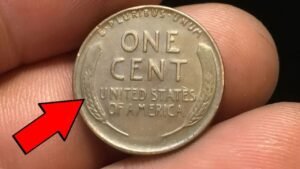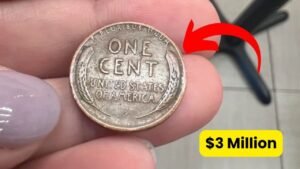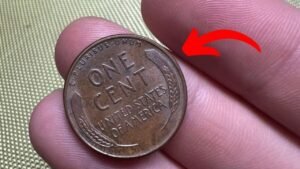Have you ever tossed a penny into a jar without a second thought? What if that tiny coin could be worth a fortune? The Lincoln Wheat Penny, a seemingly ordinary one-cent coin, has captured the imagination of collectors and treasure hunters alike. Some rare versions, particularly the 1943 copper penny, are rumored to be worth up to $1 million or more. Could one of these valuable coins be hiding in your change? Let’s dive into the fascinating story of the Lincoln Wheat Penny, why it’s so special, and how you can identify one that might change your life.
What Is the Lincoln Wheat Penny?
The Lincoln Wheat Penny, often called the “Wheat Cent,” was first minted in 1909 by the U.S. Mint to celebrate the 100th anniversary of President Abraham Lincoln’s birth. Designed by sculptor Victor David Brenner, it was groundbreaking as the first U.S. coin to feature a real person instead of the symbolic Lady Liberty. The obverse (front) showcases Lincoln’s profile, while the reverse displays two wheat stalks framing the words “ONE CENT” and “UNITED STATES OF AMERICA.” This iconic wheat design, which gave the coin its nickname, was used until 1958, when it was replaced by the Lincoln Memorial Penny.
These pennies were made of 95% copper until 1943, when World War II changed everything. Copper was needed for military supplies, so the Mint switched to zinc-coated steel. However, a few rare 1943 pennies were mistakenly struck in copper, creating one of the most valuable coins in American history.
Why Is the 1943 Copper Penny So Valuable?
The 1943 copper Lincoln Wheat Penny is the holy grail of coin collecting. During World War II, copper was in high demand for ammunition and wiring, so the U.S. Mint switched to steel pennies to conserve resources. By mistake, a small number of copper planchets (coin blanks) from 1942 were left in the presses and stamped with the 1943 date. Experts estimate that only about 15 to 20 of these error coins exist today, making them incredibly rare.
Their value comes from three key factors:
- Rarity: With so few in existence, these coins are a collector’s dream.
- Historical Significance: The wartime error ties them to a pivotal moment in history.
- Condition: Coins in pristine, uncirculated condition fetch the highest prices.
For example, in 2010, a 1943-D bronze penny (minted in Denver) sold for $1.7 million at auction. Another was valued at $2.3 million in mint condition. While claims of pennies worth $88 million or more exist, these are often unverified and likely exaggerated. Still, even a circulated 1943 copper penny could fetch hundreds of thousands of dollars.
A Real-Life Treasure Hunt: Stories of Discovery
The idea of finding a million-dollar coin in your pocket sounds like a fairy tale, but it’s happened before. In 1947, a teenager named Don Lutes Jr. received a 1943 bronze penny in change at his high school cafeteria in Pittsfield, Massachusetts. He held onto it until his death in 2018, when it was auctioned for $204,000 by Heritage Auctions. The proceeds went to a local library, proving that these coins can leave a lasting legacy.
Another story involves a New Jersey man who found a 1943 copper penny in his late father’s coin collection. After authentication by the Professional Coin Grading Service (PCGS), it was valued at over $100,000. These stories show that rare pennies can turn up in unexpected places—piggy banks, inherited collections, or even loose change.
How to Identify a Rare Lincoln Wheat Penny
Could you have a valuable penny in your possession? Here’s how to check. Focus on the 1943 copper penny and other key dates like the 1909-S VDB or 1955 Doubled Die Obverse. Follow these steps:
Step 1: Check the Date and Mint Mark
Look at the year on the coin. The 1943 copper penny is the most famous, but other valuable years include:
- 1909-S VDB: Only 484,000 were minted, and the designer’s initials (VDB) were removed due to controversy, making it rare.
- 1914-D: Only 1.2 million were produced, valued at up to $159,000 in mint condition.
- 1955 Doubled Die Obverse: Features noticeable doubling in “LIBERTY” and “IN GOD WE TRUST,” worth up to $224,831.
Check the mint mark below the date:
- D for Denver
- S for San Francisco
- No mark for Philadelphia
The 1943-D copper penny, with the “D” mint mark, is the rarest of all.
Step 2: Perform the Magnet Test
Since most 1943 pennies are steel, a simple magnet test can help. Place a small magnet near the coin:
Step 3: Weigh the Coin
Copper pennies weigh about 3.11 grams, while steel pennies weigh around 2.7 grams. Use a precise digital scale for accuracy.
Step 4: Look for Errors
Minting errors like doubled dies (where text or images appear doubled) or off-center strikes can significantly increase a coin’s value. Use a magnifying glass or your phone’s camera to inspect for unusual details.
Step 5: Get Professional Authentication
If you suspect you have a rare penny, don’t clean it—cleaning can reduce its value by damaging the surface. Contact a reputable grading service like PCGS or NGC for authentication. They use the Sheldon scale (1–70) to grade coins based on condition, which heavily impacts value.
Other Valuable Lincoln Wheat Pennies
While the 1943 copper penny steals the spotlight, other Wheat Pennies are worth checking for:
| Year | Mint Mark | Estimated Value (Mint Condition) | Why It’s Valuable |
|---|---|---|---|
| 1909-S VDB | S | $100,000+ | Low mintage, designer’s initials controversy |
| 1914-D | D | $159,000 | Only 1.2 million minted, highly sought after |
| 1926-S | S | $149,500 | Rare in bright red condition |
| 1943 (Copper) | D or none | $1.1M–$2.3M | Wartime minting error, extremely rare |
| 1955 Doubled Die | None | $224,831 | Prominent doubling error |
These coins, especially in uncirculated condition, can fetch impressive prices at auction.
The Thrill of Coin Collecting: Why It Matters
Coin collecting, or numismatics, is more than a hobby—it’s a journey through history. Each Lincoln Wheat Penny tells a story, from the Great Depression to World War II. Collectors like John Smith, a numismatist with 20 years of experience, describe the thrill of the hunt: “Finding a rare coin is like uncovering a piece of the past. It’s not just about the money—it’s about holding history in your hand.”
The Lincoln Wheat Penny’s historical significance adds to its appeal. Minted during times of economic hardship and war, these coins are tangible links to America’s past. Their value isn’t just financial; it’s cultural.
Where to Find Rare Lincoln Wheat Pennies
You don’t need to be a professional collector to strike gold. Here are some places to look:
- Loose Change: Check your pocket change or cash register returns. Rare coins occasionally surface in everyday transactions.
- Coin Rolls: Buy rolls of pennies from banks and search through them.
- Estate Sales and Flea Markets: Older households may have stashed away valuable coins.
- Inherited Collections: Check family heirlooms or old piggy banks.
How to Sell a Rare Penny
If you find a potentially valuable coin, here’s how to proceed:
- Authenticate: Get it graded by PCGS or NGC to confirm its authenticity and condition.
- Research: Check recent auction prices on sites like Heritage Auctions or eBay to gauge market value.
- Sell Strategically: Options include:
Tips to Protect Your Coins
Preserving a coin’s condition is crucial for maintaining its value. Follow these tips:
- Handle Carefully: Touch coins only by the edges to avoid oils from your skin.
- Avoid Cleaning: Cleaning can scratch the surface and reduce value.
- Store Properly: Use professional-grade plastic holders to protect against moisture and dust.
The Future of the Lincoln Wheat Penny
With talks of phasing out the penny due to high production costs (nearly 4 cents per penny), the Lincoln Wheat Penny’s legacy grows even more significant. Former President Donald Trump’s 2025 announcement to cease penny production sparked debate, but collectors argue these coins are more than currency—they’re history. As fewer pennies circulate, the value of rare Wheat Pennies may climb higher.
Final Thoughts: Could You Be Holding a Fortune?
The Lincoln Wheat Penny is a reminder that treasures can hide in plain sight. A coin worth $1 million might be sitting in your change jar, waiting to be discovered. By checking dates, mint marks, and materials, you could uncover a piece of history that’s also a financial windfall. So, next time you find an old penny, take a closer look—it might just be your ticket to a life-changing payday.




